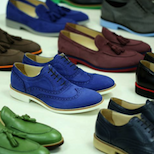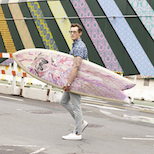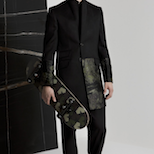The Story of Ozwald Boateng
11.28.2012
STYLE
Regardless of peoples’ various backgrounds, there remain universal themes that exist within everyone. Director Varon Bonicos hits on this point in his recent film, A Man’s Story, a documentary delving deeply into the life of world-famous British designer Ozwald Boateng. The documentary began filming in 1998, and Bonicos followed Boateng for 12 years, catching the designer at his emotional highs and lows. Despite Boateng’s prestige and constant presence among some of the world’s most famous actors, including Will Smith, Jamie Foxx and others, he never comes off arrogant. In A Man’s Story, we see the designer go through two divorces, successful yet stressful fashion shows and a burglary at his shop in London’s Savile Row. At the same time, Bonicos catches the moment he first meets his second wife, becomes the creative director for Givenchy and puts together a fashion show for the African Union Summit in Ghana. “The thing about being ambitious and being a pioneer, is there’s a lot of accolades that you get. But there’s a lot of consequences to the accolades,” says Boateng. “The film touches on that and it’s up to [the viewer] to figure out what speaks to you. You don’t have to be a celebrity to understand it. The film is like my suits. It’s kind of bespoke to the person. It’s my role as the tailor to understand the best way to clothe you in the most flattering way, but more importantly, enhance the characteristics of who you are. In a way, I don’t know how exactly, but maybe the film does a similar sort of thing. It seems to be bespoke to the individual. From the responses that I’ve had – thousands – I can say that it does that.”
Amassing more than 500 hours of footage, Bonicos cut that down to 98 minutes to seamlessly string together the last decade of Boateng’s life. Here we catch up with the designer and the director, talking about the filming process and Boateng’s success as one of the world’s most sought after tailors.
Life+Times: What was your initial reaction when first approached about being the subject of the film?
Ozwald Boateng: Well the thing is, the film was a gradual development. Initially, Varon was supposed to film over a four to six week period. What happened was a series of events took place in the fashion that you see in the film, and he became more interested to see what I would do next. So the six weeks became six months, which became a year, which became five years and eventually 12. In a way, it’s one of those things where you kind of allow it to find its own way. And even when you see the way the film is put together, when you’re watching it, it kind of guides you and then eventually you come to a conclusion. But the conclusion is different for everybody. So that’s really what my journey with the film has been about. When I saw the final edit of the film, it took me weeks to talk to Varon. I couldn’t actually say anything about it. In fact, I was in shock. It’s quite a hard-hitting film. It touches on a lot of emotional points; so for me, as you can imagine, if that’s the details of your life, there’s moments in that film that I remember the day, the week, the month. So I also get lost in the film. It was a very powerful experience for me.
L+T: Talk about the relationship you formed with each other, filming for 12 years.
Varon Bonicos: To film Ozwald and all of the things that surround him, and try to fit into that world with a camera – to be able to film Will Smith – it’s not an easy task. Obviously, I have to be friends with Ozwald, but simultaneously be one step back because I’m making a documentary about him. So in order to make a credible piece of work, it was very important to step back from him and also be friends with him. It’s very difficult balancing that. What the film is about is simply the journey of a man, which is also the most complicated and most important journey I think that we all take; we really don’t know what lanes we’re gonna go down, so when I filmed I didn’t know which road I was going down, as none of us know which road we’re going down. So, obviously not just being nice for the sake of being nice, and getting on with Ozwald very well [during filming], now I can get on with him better and we can hang out. I can relax a bit, but during the time of filming it was very important to try to disappear as much as possible, so that’s what I tried to do. That’s why I chose to shoot in such a way where I used a very long lens on the camera – from 100 up to 300 mils – which is quite long for a documentary lens. I kept out of his way.
OB: Most of the time Varon was filming, I was unaware of it, because you just couldn’t feel his presence in the room. The reason why the documentary has that feel to it is because I had no awareness of the camera for at least 60 to 70 percent of the time.
L+T: Were there ever times when you were filming where you questioned whether or not you should stop because it may be a bit too much?
VB: Ozwald, and everything in that film, is 100 percent non-sugarcoated and real. Ozwald didn’t not let me film anything, I just used my discretion as to what not to film and what to film. Obviously, were some things that I wouldn’t consider filming. I’ve got like, 500 or 600 hours of unused material, and we’ve got 98 minutes cut into a film, so there’s so much stuff that’s unused. For instance, there’s like an hour-and-a-half of Mos Def impersonating Ozwald. Ozwald wasn’t even there. You could put titles on it and that could be a film. There were no restrictions on anything at all, it was just a question of catching all these moments in a man’s life and allowing them to tell a story. There’s a great backdrop of celebrities and fashion, but the fundamental core of it is something that happens to everybody, which is this progression of life and balance of work.
L+T: Talk about the experience of having your entire life documented. Did you get a chance to look at any of the raw footage?
OB: Definitely, because I’d see him filming or he’d say, “Look at this,” or something would happen and he’d show me that he captured it, and I couldn’t believe that he even filmed it. So I kind of had an awareness, but out of 600 hours of footage, the awareness I had might amount to an hour or an hour-and-a-half. Then the editing process was really up to Varon. I had to trust that he’d do it in a way that would be true to what needed to be done.
L+T: What was your intent in documenting all of this?
VB: To be honest with you, the intent gradually changed over the years. The intent is like riding a bicycle: that to keep your balance, you have to keep moving. We always forget about the very basic things in life when we get stressed or when life hits us, so to see an example of Ozwald, to see what he had to do his life in balance and how he had to keep moving. A couple of people told me, “that [film] really, really helped me,” and to be honest, that’s kind of enough. The more that I get of that, the better it is. I don’t want to see it’s self-help, but it does kind of board on that.
L+T: What’s it like to be the first Black man with a shop on Savile Row?
OB: The thing is, I was born in London. And we touched on it a bit in the film. There were definitely issues for me growing up here. Like I said in the film, we have choices. Either it can be a burden and an issue, or you can go on in life. I chose for it not to be an issue. That doesn’t mean it wasn’t an issue, I just didn’t see it. I made that decision very early on in life. I was at school and there were only three Black kids in the whole school, so you just go on with it. It’s not that I was ignoring what I was, no. But my purpose became about getting on and succeeding. Savile Row is a very famous street. By me opening a shop on Savile Row and me having an influence on the street, had a great meaning to society here in the UK. By having that influence, it meant that I was expanding what I means to be British. So the importance of me opening a shop there was that, and I can say it was a subconscious thing. I say subconsciously because I knew the concept of Savile Row on one hand and I wanted to breathe new life into it, and I knew it had something unique and should be on the global stage for menswear, and I knew what to do to make it be that. It just needed more of a designer approach. So from a British city standpoint, I took a concept and breathed new life into it and kind of restructured the global awareness of that and developed a reputation of putting the structure back into suits. Effectively, that’s what I did. Giorgio Armani took the structure out and I put the structure back in.
L+T: How has your African descent and Ghanian roots influenced your work?
OB: My African roots, I never really used them as tools in my work – initially. But what happened, as I was developing a new kind of approach to tailoring and menswear, I knew that color wasn’t really used. When I started, it was only black, white, grey and navy that were the color palettes. So I first developed my name from my cutting, then moved on to detail, then I got into using color in menswear in a way that made color respectable. So I used it in lining on the inside of jackets, then that expanded into the shirts and the ties, and eventually ended up in the fabric. I was using color like a painter. From that, that’s when my cultural roots started connecting, in the way that I used color. But I wasn’t consciously trying to use my African roots as my basis. My basis was I want to create something unique and new. But now, I have to say, many years, later, I’m very conscious of my African roots and I suppose more vocal and expressive of that culture within my work. I’m also using sometimes now African fabrics in my work.
L+T: Any style tips?
OB: Yes, I have some style tips. I like shirts that have bones in the collar so it gives a nice angle. I like when the angle of the tie in nicely balanced on both sides, and obviously, I’m always gonna say having a suit that’s cut to you well is the ultimate clothing for a man, because what it does, it respects who they are. Footwear is always a big point for men and in menswear trousers, so depending on what type of shoe you wear determines the width of the trouser at the bottom.
A Man’s Story premiered in L.A. and New York earlier this month and is now available on iTunes and Amazon.





